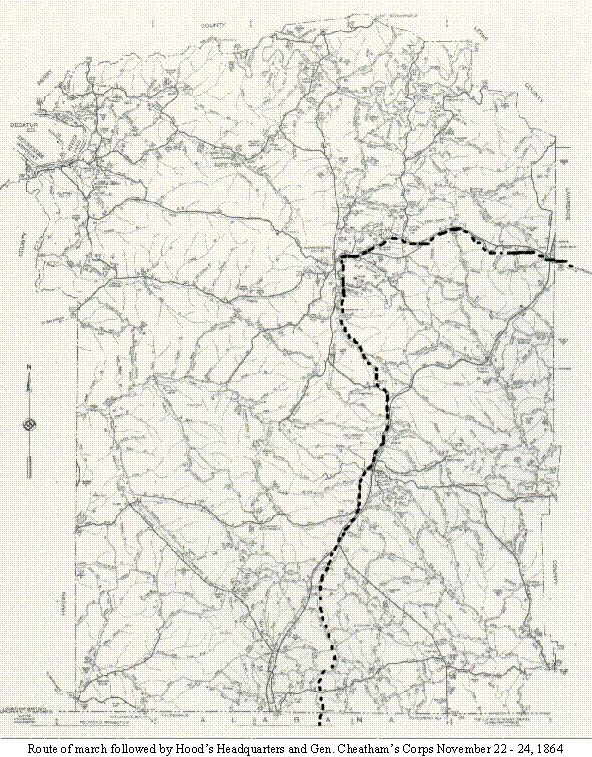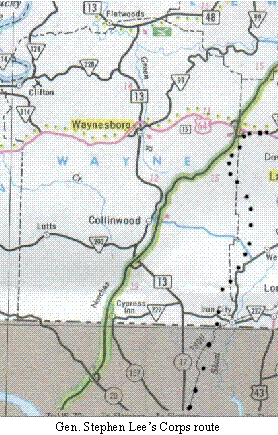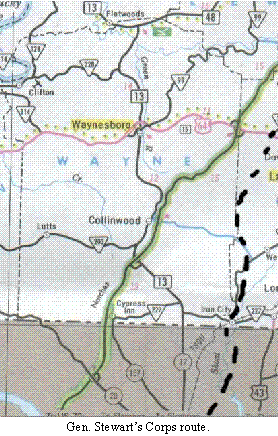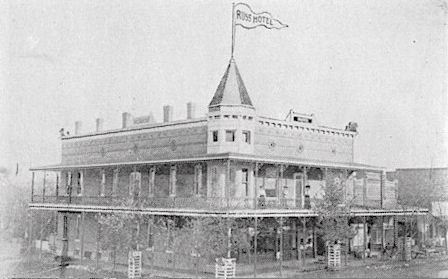The Burning Of Clifton
by William R. Morris
Originally published in the “Wayne County Historian”
Volume 2, Number 2, June 1989
War is never a good thing, especially for the people caught in its path. The Tennessee River town of Clifton, Tennessee seemed to be caught in the path sporadically throughout the Civil War. A tragic turn of events occurring in February 1863, left some of the residents of Clifton homeless.
The Civil War brought a hard life to John Newsom. John answered his new country’s call for volunteers by joining the 6th Infantry Regiment of the Provisional Army of Tennessee. John was soon made Captain of Company F of that unit. In a short time the 6th Infantry was placed into Confederate service.
Although the 6th Tennessee Infantry Regiment rendered good service early in the Civil War, it was nearly destroyed during the Battle of Shiloh. The regiment withdrew from the battle having suffered nearly 500 casualties of its 851 men. Captain Newsom’s company was disbanded and its surviving members assigned to other units.
Brigadier General Gideon J. Pillow, finding Newsom without a command, authorized him to form a new cavalry regiment behind the lines for Confederate service. Newsom, now having been appointed a colonel, not only began recruiting, but engaged in military operations against Federal units in the area. February 1863 found Newsom and a number of his men in Clifton. Clifton, just the month before, had been the location of Confederate General Nathan B. Forrest’s temporary brigade headquarters after his Christmas raid through west Tennessee.
The 3rd Michigan Cavalry Regiment came into Middle Tennessee after a good deal of hard campaigning. The regiment had participated in the siege of New Madrid, the siege of Island Number 10, and the siege of Corinth, Mississippi. The 3rd continued its actions against the Confederates in middle and west Tennessee and northern Mississippi. There is little doubt that such continuous fighting shaped these Grand Rapids citizen soldiers into war-hardened veterans.
The State of Michigan saw to it that its 3rd Cavalry was exceptionally well equipped. They had been furnished with the new Sharps breach loading rifles and carbines. This weapon allowed the cavalryman to rapidly reload far faster than the normal muzzle-loaders of their opponents. The regiment had also bee issued a number of the new multi-shot Colt Revolving rifles. They were also furnished a large number of various types of handguns (revolvers).
By way of comparison, the normal Confederate cavalry regiment was equipped with what weapons they could get. Normally they would use various kinds of shotguns, flintlocks, and other assorted muzzle-loaders. Confederate troops continued throughout the war to arm themselves with what Union weapons they could capture or pick up from the battlefields. There is little question that during February 1863, the 3rd Michigan Cavalry had Newsom’s cavalry outgunned.
On 13 February 1863, a Tuesday, the 3rd Michigan Cavalry sent out a scouting party from Lexington, Tennessee towards Clifton. The party was composed of companies A, B, K, and L of the 3rd Michigan and SGT Mize and 14 men from the 7th Tennessee Cavalry Regiment (US Volunteers), acting as guides. The group was under command of CPT Cicero Newell.
On 19 February, the group approached Clifton from the west die of the river. Newell had received word that “…the noted Colonel Newsom …” and his men, which were considered to be guerrillas, could be found at “the old haunt, Clifton”.
While scouting the vicinity some of Newell’s men found a sunken flatboat, about 20 miles above Clifton. Newell formed a plan of attack. Leaving SGT Vowell and 6 men from Company K to bail out and refloat the flatboat, Newell made the appearance of returning to Lexington. When the local residents were apparently convinced of this action, and Newell was out-of-sight of the populace, he hid his men in the forest until nightfall. He then returned to the river with his men where he met SGT Vowell, now about four miles above the town with the flatboat. Newell found the boat to be too small to carry his whole command. With time running short, Newell could only make one crossing of the river. Taking 60 troops with him, Newell crossed the river, leaving the remainder on the west side. On landing, precious time was lost as the party was delayed in the swamps near the town. However, they were able to surround the town shortly before dawn.
As dawn broke, Newell began his surprise attack on the sleeping Confederates. The attack was fast and furious, catching many of the rebels still asleep in bed. The Confederates fought back, but it was over quickly. As a result of the attack, Newell’s party captured 54 of Newsom’s force and a number of their horses. Newell was wounded in the attack and CPT Frederick C. Adamson assumed command of the party. With the capture of the rebels, the town of Clifton was set ablaze.
As the town burned, the US Gunboats “Fairplay”. “Lexington”, St. Clair”, Brilliant” and “Robb” approached along the river. The little fleet was on their way up the river to check reports of Confederate activity. The group was under the command of Lieutenant Commander Leroy Fitch who observed CPT Adamson signaling him to land. On his landing, Fitch spoke with Adamson and was made to understand what had just occurred. Adamson feared a Confederate counterattack and requested Fitch’s assistance in crossing the river with his force and the captured horses. Adamson was also uncertain if he could safely return to Lexington with so many prisoners. Fitch agreed to assist in the crossing and to take care of the prisoners for Adamson. Col. Newsom, who had been captured, was found to be severely wounded and was paroled and released at Clifton.
Later that afternoon Fitch transported 40 of Adamson’s dismounted troops to Eagle’s Nest Island in search of additional rebels and their stores. This party later returned having found neither men nor supplies. Adamson withdrew his party to Lexington.
Was it necessary that Clifton be burned? Little now exists to give a valid answer either way. It is known that in February 1862, the Captain of the US Gunboat “Tyler” confiscated a large amount of supplies at Clifton. Supplies which he felt were destined for the rebels. Contemporary reports tend to indicate that the residents of Clifton were housing Newsom’s force. The Union troops may have felt that the town was composed of Confederate sympathizers. On the other hand, it is known that in July 1863, after a battle near Jackson, Tennessee the 3rd Michigan Cavalry was accused of the drunken looting of a millinery store in Jackson. Whatever the reason, the burning left the residents of Clifton without their homes for the winter.
Sources:
The Civil War Centennial Commission Of Tennessee, Tennesseans In The Civil War, Part I, University of Tennessee Press, Nashville, TN 1984
Michigan Civil War Centennial Observance Commission, Small Arms Used By Michigan Troops In The Civil War
Dyer, Frederick H., A Compendium Of The Of The War Of The Rebellion, Morningside Bookshop (reprint 1978)
U.S. Government, Official Records Of Union And Confederate Navies In The War Of Rebellion: Naval Forces Of Western Waters, Government Printing Office, 1896
U.S. Government, War of Rebellion, A Compilation Of The Official Records Of Union And Confederate Armies, Washington, DC
Robertson, Jno., Adjutant General, Michigan In The War, W. S. George & Co., Lansing, MI 1882.




